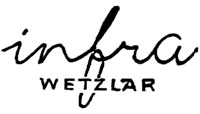
B.J. Oehler Feingerätebau started building cameras in Wetzlar (of Leica fame) in 1950. The Infra was the only camera it ever built. The Infra was a simple camera which used Karat cassettes instead of 135 film rolls and produced 24x24 mm square negatives. It featured an extinction meter in which one could see the numbers 1 to 8 depending on the available light. The numbers differ by one stop each. A table that list matching apertures and shutter speeds exists, but it does not mention the film speed. Taking the sunny 16 rule as a base, the value of 1/50s at f/16 for the lowest number, 1, indicates a film speed of ISO 50 or less. A copy of the table can be found at the bottom of this page.
On the internet I have seen several descriptions of the Infra line-up which divides them in five versions mostly based on the shutter version. I find this a bit strange, most cameras came with several shutter and lens combinations and different models are usually distinguished by other features. Here I present what I think is the most sensible classification of the various Infra versions.
In addition, some websites report the existence of two versions, one with wind knob on the right and one with the wind knob on the left. However, I cannot find any images of the latter, so did it really exist? Also mentioned is the existence of a 32,3 mm lens in addition to the common 35mm lens, again, no record exists. Even more so, several sales brochures mentioned an interchangeable 70mm f/4 telelens. Again, it is unclear if these were actually ever made. But one can never say never, perhaps one will pop up one day! [UPDATE: Indeed it has, a 70/4 Punktar lens with serial# 23925 was for sale on a late v.3 Infra on eBay in December 2017]
Oehler Infra v.1
The first version had a lens that was focussed by turning the inner ring on the lens front, this is rather fiddly as the ring is quite small. The lens was a Felgner Punktar 35mm f/2.8. The shutter is a Pronto of the self-cocking type. All cameras that I have seen that have this lens have lens serial numbers between 10,107 and 11,327.
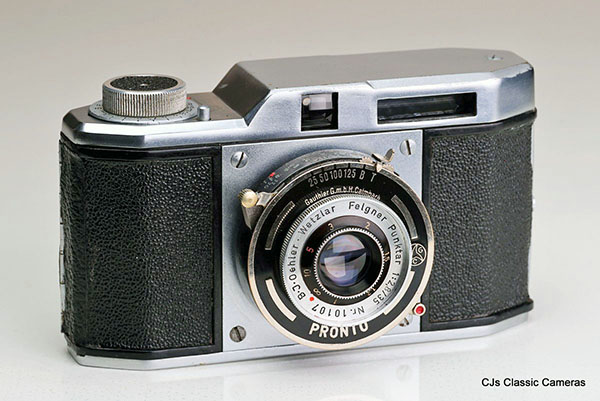
First version of the Infra. The lens was focused by turning the black inner ring. The 'Infra' engraving on the top appears to be missing, but it is still there, very faintly. A previous owner must have scratched the top and sanded it down and repainted it. The bad thing is that I got this from a reputable camera shop, but they failed to notice or mention this, and it wasn't really clear from their pictures. Disappointing, and not the first time this company messed things up.
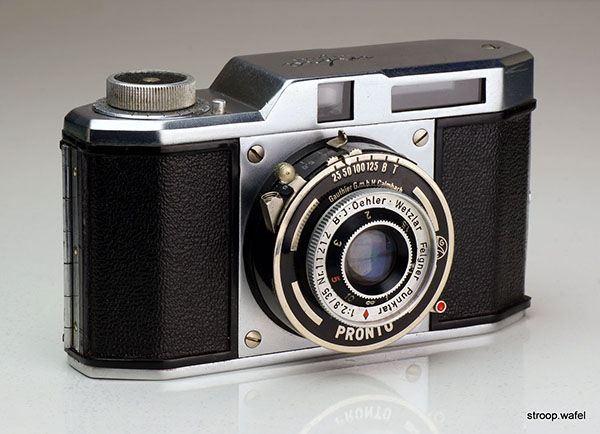
Later production of the first version of the Infra had a red diamond instead of a red dot as focus indicator. The lowest serial# I have seen was 10933. 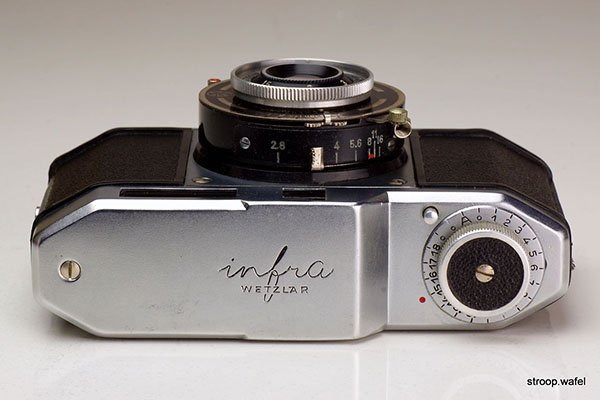
Top view of Infra v.1. Note the black leather wind covering of the wind knob, later versions had a grooved metal top.
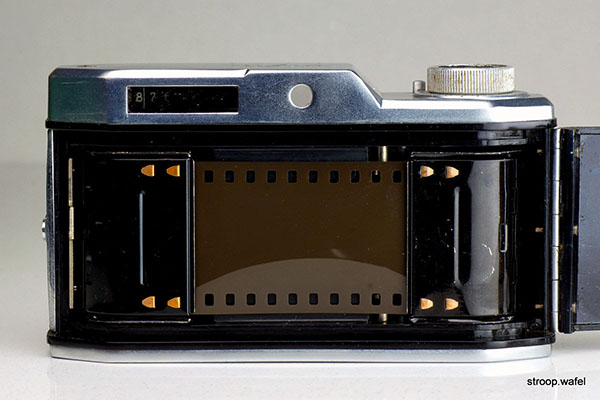
An Infra from the inside with Karat cassettes and film loaded. Some numbers of the extinction meter are also visible.
Oehler Infra v.2
The second version of the Oehler Infra was characterised by a metal focus ring with a flat face in which the focus scale was engraved. Focussing was rather cumbersome with this lens, as at infinity the front of the lens ring was flush with the ring around it, so one had little grip on the lens. The lens was still a Felgner Punktar 35mm f/2.8, with the name indicated on the inside of the focus ring. The shutter was a Pronto. All cameras that I have seen that have this lens have lens serial numbers between 12,076 and 12,890, which suggests a production of less than 1,000 cameras.
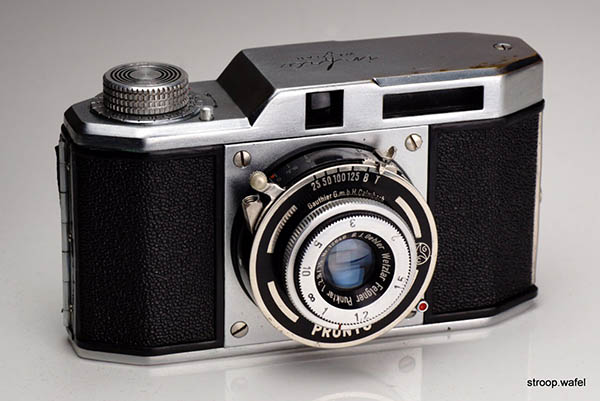
The second version of the Infra. Note the change in focus ring compared to version 1. The wind knob was also different, plus an arrow indicating the wind direction had been added.
Oehler Infra v.3
The third and last version had a more traditional lens focus ring design like, e.g., Cassar and Kata lenses. The name of the lens is printed on the front of the focus ring, the distance markers are engraved on the outside. All cameras that I have seen that have this lens have lens serial numbers between 12,600 and 25,468, but there was some overlap of early serial nrs with the late ones of the second version. This version of the Oehler Infra usually came with a Pronto shutter but some examples had Vario shutters. Late production had a silver coloured shutter plate. The regular Pronto version was also sold under the name Lopica, probably only in extremely small numbers.
In conclusion, there are three different versions of the same lens, with consecutive, not overlapping serial numbers. Assuming numbering started with 10,000, about 1500 were made of each of the first two versions, and over 12,000 of the third version. Thus, a fairly rare camera, particularly the first two versions.
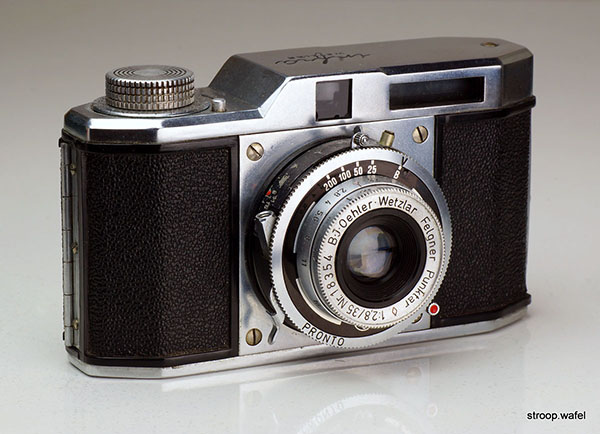
The third version of the Infra. Even though it has the same lens as the first two versions, the markings and focus ring are different. It was otherwise identical to the previous version.

Top view of Infra v.3. This version had concentric grooves on top of the wind knob, not black leather like the first Infra. The arrow indicating the rotation direction of the wind knob is also new (but already appeared on version 2).

Late production version of the Infra v.3 with silver shutter plate. This change happened around lens nr. 24,000, which means only about 1500 of these were made.
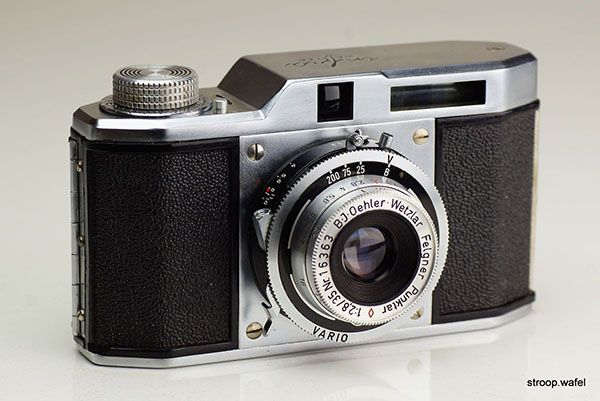
The Infra v.3 came also in a Vario shutter version with one less shutter speed and no time delay. It was otherwise identical to the Pronto model.

This is one of the earliest Infra v.3. It is nearly identical to the Pronto model above, but the wind knob is similar to the Infra v.1 and some of the Infra v.2, and the extinction meter goes up to seven, not eight like the later v.3 Infras and is also in the opposite order.

Is this the elusive Infra with telelens? Alas not, it is just a gimmick where someone mounted the lens and shutter of presumably an Adox Golf folding camera. It doesn't even focus properly, but it looks pretty cool.
Exposure table
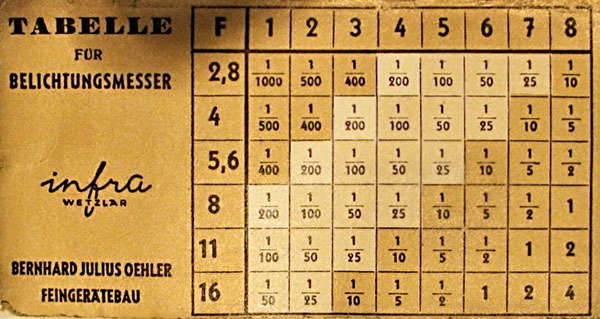
Exposure table for the Infra extinction meter. I have lightened the shutter speeds available on the Prontor shutter, only the later version reached 1/200s. It appears the best way to use the extinction meter was to set the shutter speed to 1/50 and close the aperture by one stop for each change in extinction value, counting from f/2.8 and extinction value 6. Image source: Paolo Bologna, Flickr.
| 
